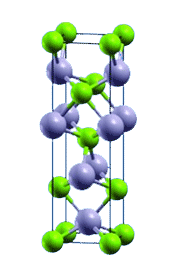What molecule am I?


OK, all you chemists: Do you know what pnictogens are?
Despite the odd name, pnictogens are pretty mundane. They are the elements in group 15 of the periodic table: nitrogen, phosphorus, arsenic, antimony, and bismuth. Elemental nitrogen is a gas, of course; the others are solids with increasing metallic character from low to high atomic number.
Salts that contain pnictogen anions are called pnictides. Much current research is focusing on binary pnictides that have unusual properties (e.g., diamagnetism and paramagnetism) because their bonding is a hybrid of ionic and covalent.
Tantalum arsenide (TaAs) is a binary that has received much attention in the past 40 years. Its thermodynamic and crystalline properties were established in the 1970s–1990s. More recently, Liwei Guo, Xialong Chen, and co-workers at the Chinese Academy of Sciences developed a method for growing large TaAs crystals so that the compound could be studied more extensively. Its body-centered tetragonal unit cell is shown in the figure.
So why is there so much interest in TaAs? The trail leads us to particle physics. Specifically, Weyl fermions—charged, massless subatomic quasiparticles proposed by German mathematician–theoretical physicist Hermann Weyl (1895–1955)—were long thought to exist but never observed. But 60 years after Weyl’s death, M. Hamid Zashan at Princeton and coauthors worldwide discovered that single-crystal TaAs hosts Weyl fermions; hence the substance is called a “Weyl semimetal”.
The work of Guo, Chen et al. and Zashan et al. gave rise to a profusion of research on Weyl fermions and semimetals. Nobel Prize in Physics, anyone?

Learn more about this molecule from CAS, the most authoritative and comprehensive source for chemical information.
Molecule of the Week needs your suggestions!
If your favorite molecule is not in our archive, please send us a message. The molecule can be notable for its current or historical importance or for any quirky reason. Thank you!
Stay Ahead of the Chemistry Curve
Learn how ACS can help you stay ahead in the world of chemistry.

